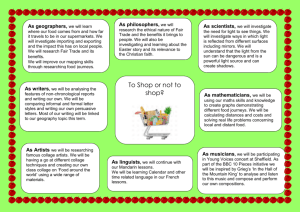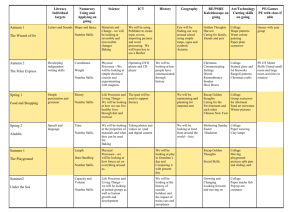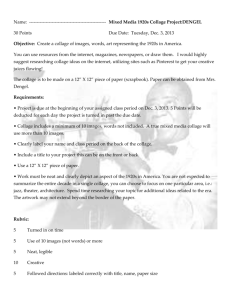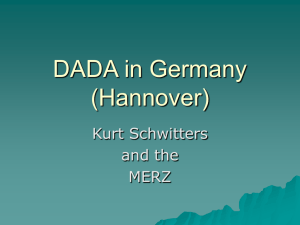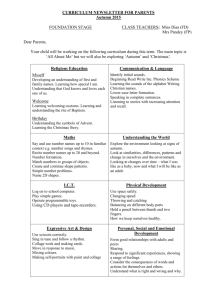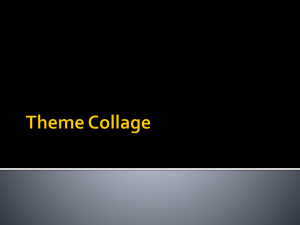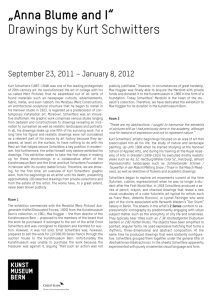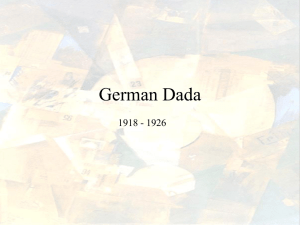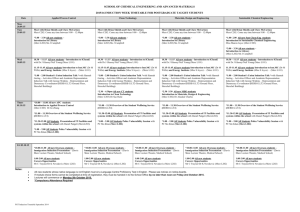SURREALISM WORKSHEET SOURCE: MOMA.ORG REVEALING
advertisement
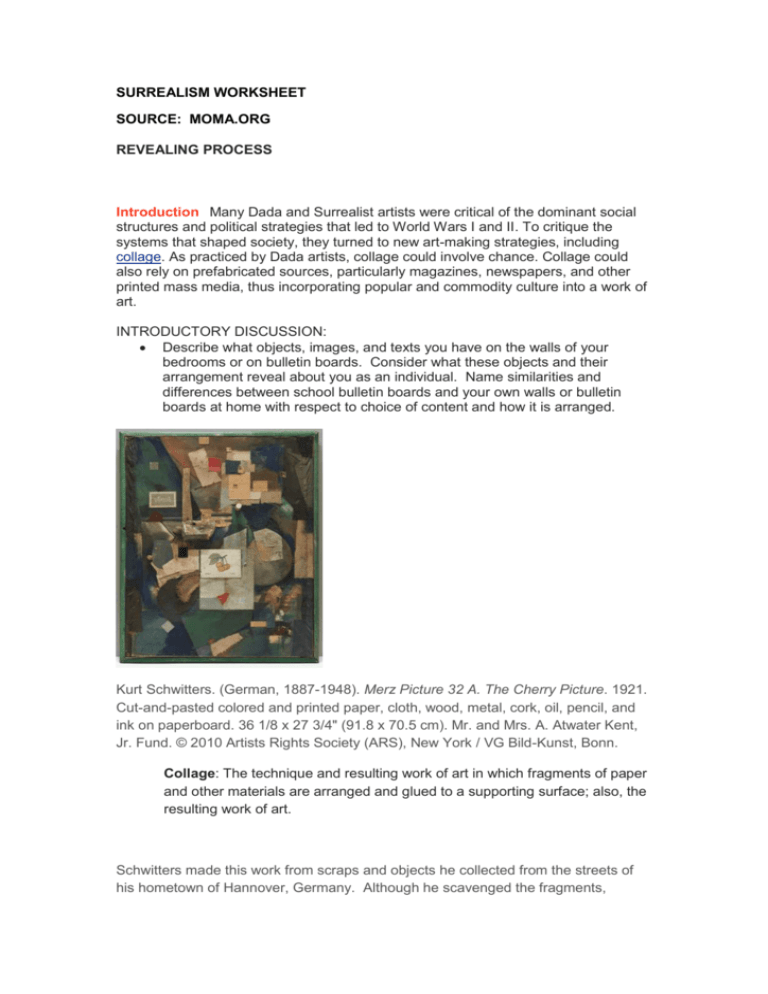
SURREALISM WORKSHEET SOURCE: MOMA.ORG REVEALING PROCESS Introduction Many Dada and Surrealist artists were critical of the dominant social structures and political strategies that led to World Wars I and II. To critique the systems that shaped society, they turned to new art-making strategies, including collage. As practiced by Dada artists, collage could involve chance. Collage could also rely on prefabricated sources, particularly magazines, newspapers, and other printed mass media, thus incorporating popular and commodity culture into a work of art. INTRODUCTORY DISCUSSION: Describe what objects, images, and texts you have on the walls of your bedrooms or on bulletin boards. Consider what these objects and their arrangement reveal about you as an individual. Name similarities and differences between school bulletin boards and your own walls or bulletin boards at home with respect to choice of content and how it is arranged. Kurt Schwitters. (German, 1887-1948). Merz Picture 32 A. The Cherry Picture. 1921. Cut-and-pasted colored and printed paper, cloth, wood, metal, cork, oil, pencil, and ink on paperboard. 36 1/8 x 27 3/4" (91.8 x 70.5 cm). Mr. and Mrs. A. Atwater Kent, Jr. Fund. © 2010 Artists Rights Society (ARS), New York / VG Bild-Kunst, Bonn. Collage: The technique and resulting work of art in which fragments of paper and other materials are arranged and glued to a supporting surface; also, the resulting work of art. Schwitters made this work from scraps and objects he collected from the streets of his hometown of Hannover, Germany. Although he scavenged the fragments, Schwitters carefully composed and affixed them with glue and nails to a painted board to make this collage. Schwitters was trained as a painter, but as World War 1 came to an end he adopted collage as his preferred process, saying, “[…] everything had broken down in any case and new things had to be made out of the fragments.” Merz Picture 32A belongs to the so-called Merz series, a term Schwitters derived from a syallalbe of the German word “Kommerz” (commerce), which he included in one of his early collage pain tings. Merz Picture 32A has many layers. Light and dark paint on the board form the base of the collage and contribute to an illusion of depth. Affixed are various fabrics, an image of kittens, newspaper clippings, and a flashcard of cherries, onto which Schwitters penciled in German the ungrammatical phrase, “Ich liebe dir!” (I love she!). Three-dimensional objects, such as a wine cork and a broken pipe, protrude from the surface. Schwitters stated that with his Merz projects he aimed “to create connections, preferably between everything in this world.” Jean (Hans) Arp. (French, born Germany (Alsace). 1886-1966). Untitled (Collage with Squares Arranged according to the Laws of Chance). (1916-17). Torn-andpasted paper and colored paper on colored paper. 19 1/8 x 13 5/8" (48.5 x 34.6 cm). Purchase. © 2010 Artists Rights Society (ARS), New York / VG Bild-Kunst, Bonn. The following passage was written by Arp’s friend and fellow artist Hans Richter. Apparently, Arp, frustrated with a drawing he had been working on for some time, [. . .] finally tore it up, and let the pieces flutter to the floor of his studio[. . . .] Some time later he happened to notice these same scraps of paper as they lay on the floor, and was struck by the pattern they formed. It had all the expressive power that he had tried in vain to achieve. How meaningful! How telling! Chance movements of his hand and of the fluttering scraps of paper had achieved what all his efforts had failed to achieve, namely expression. He accepted this challenge from chance as a decision of fate and carefully pasted the scraps down in the pattern which chance had determined. [Hans Richter, Dada: Art and Anti-Art (London: Thames & Hudson Ltd., 2002), 51.] 1. Does knowing how this collage was made changes your initial ideas about it. Why or why not? Arp made many collages according to chance. To remove his own artistic intervention even further, he sometimes used a paper cutter to cut the squares rather than tearing them by hand. However, there are accounts that Arp may have occasionally undermined chance and arranged the squares himself. ACTIVITIES Merz Picture 32 A can be viewed as a journal of objects encountered by the artist. Ask your students to collect five objects, images, or fragments that they find over the course of a day or weekend, and make a collage. Ask them to write a journal to accompany the visual one of found objects, explaining the objects’ significance and making connections between them. What objects did they collect? What objects did they leave behind? Both Scwitters and Arp were forced to flee their homes due to military invasions leading up to World War 11. In 1937, the Nazis confiscated thousand of modern works of art, including several of Schwitters’s Merz pictures. Many of these were included in Entartete Kunst (Degenerate art), a Nazi-organized exhibition in Munich intended as a platform to mock and condemn modern art. Ask your students to conduct research on this exhibition. How many works were in the exhibition, and why were they selected? How many people visited the exhibition, and how was I received critically? What affect did the show’s reception have on the artists whose works were in the exhibition? Were did the works of art and up after the exhibition? After students have conducted their research, ask them to discuss their findings and debate issues of censorship in the arts.
